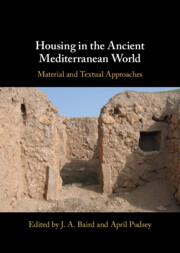Book contents
- Housing in the Ancient Mediterranean World
- Housing in the Ancient Mediterranean World
- Copyright page
- Contents
- Figures
- Tables
- Contributors
- Acknowledgements
- Introduction
- 1 Kinship ‘In the Halls’
- 2 Domesticating the Ancient House
- 3 Mind the Gap
- 4 A Family Affair
- 5 Textiles in Alkestis’ thalamos
- 6 Architectural Rhetoric and the Rhetoric of Architecture
- 7 The Reconstruction of an Agricultural Landscape
- 8 Mudbricks and Papyri from the Desert Sand
- 9 Housing and Community
- 10 The Elusive vestibulum
- 11 Living in the Liminal
- 12 Experiencing Sense, Place and Space in the Roman Villa
- 13 Houses and Time
- 14 Spaces of Desire
- 15 A Response: ‘Using the Material and Written Sources’ Revisited
- Index
- References
3 - Mind the Gap
Reuniting Words and Walls in the Study of the Classical Greek House
Published online by Cambridge University Press: 08 July 2022
- Housing in the Ancient Mediterranean World
- Housing in the Ancient Mediterranean World
- Copyright page
- Contents
- Figures
- Tables
- Contributors
- Acknowledgements
- Introduction
- 1 Kinship ‘In the Halls’
- 2 Domesticating the Ancient House
- 3 Mind the Gap
- 4 A Family Affair
- 5 Textiles in Alkestis’ thalamos
- 6 Architectural Rhetoric and the Rhetoric of Architecture
- 7 The Reconstruction of an Agricultural Landscape
- 8 Mudbricks and Papyri from the Desert Sand
- 9 Housing and Community
- 10 The Elusive vestibulum
- 11 Living in the Liminal
- 12 Experiencing Sense, Place and Space in the Roman Villa
- 13 Houses and Time
- 14 Spaces of Desire
- 15 A Response: ‘Using the Material and Written Sources’ Revisited
- Index
- References
Summary
When 19th-century excavators uncovered domestic buildings at classical Greek urban sites, they also uncovered a problem: words and walls did not match. The clash between sources led to a clash between scholars. This chapter explores the origin of this perceived gap between words and walls and shows that it is the result of clashing philosophies, rather than faulty sources. Discussions of ancient Greek houses began in 16th-century Italy, at a time when no Greek houses were available to study. Scholars created their own plans, drawing on ancient texts and surviving Roman remains. Their designs were intended to facilitate philosophical discussions, not to rebuild the past. In contrast, archaeologists wanted to rebuild. They needed labels to describe the buildings they had found. They mined ancient texts to create a terminology for domestic spaces and features. Inevitably, text and archaeology did not match. It is time to step away from the gap and re-evaluate our approach to investigating ancient houses. Through a re-examination of evidence for 4th-century BCE Athenian houses in texts and material remains, this chapter demonstrates how different ancient sources can work in parallel to advance knowledge of domestic life in the ancient Greek city.
- Type
- Chapter
- Information
- Housing in the Ancient Mediterranean WorldMaterial and Textual Approaches, pp. 96 - 132Publisher: Cambridge University PressPrint publication year: 2022



